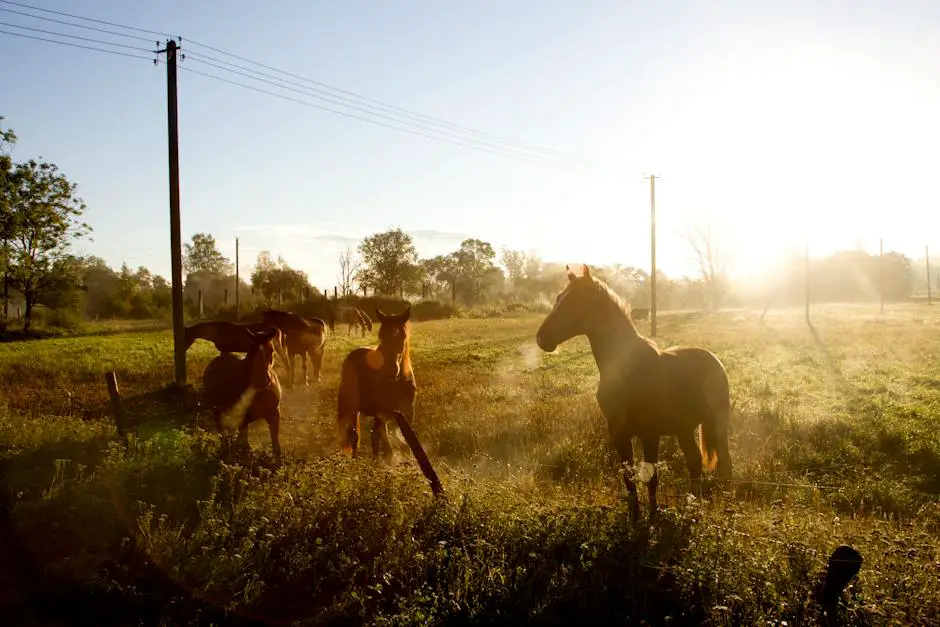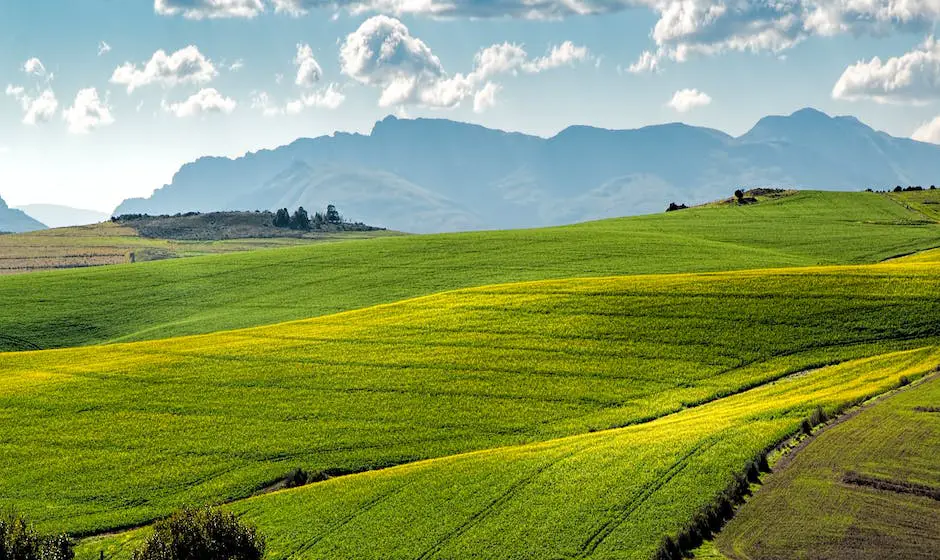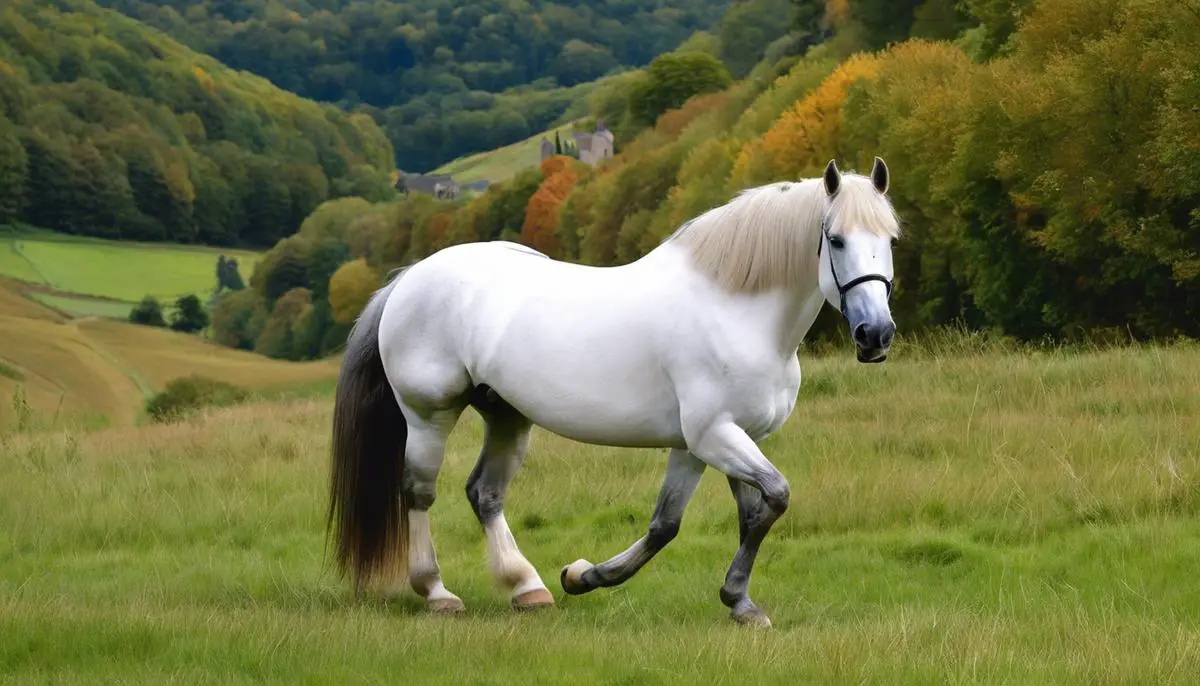Nestled within the diverse tapestry of equine breeds, the Cheval d’Auvergne stands out as a symbol of grace and resilience that hails from the volcanic landscapes of the Auvergne region in France. With a lineage as rugged and majestic as the terrain of its origin, this horse breed carries a legacy that dates back centuries. Serving various masters from farmers to soldiers, the Cheval d’Auvergne has evolved into not just a witness of history but also an active participant in shaping it. The journey to understand the Cheval d’Auvergne is to dive into a historical saga filled with both triumph and tribulation, exploring how this breed has become a prized possession for horse enthusiasts across the globe.
Table of Contents (Horspedia)
History and Origins of Cheval d’Auvergne
The Historic Trails of the Cheval d’Auvergne Horses: A Journey Through Time
Have you ever been captivated by the powerful yet elegant gallops of the Cheval d’Auvergne horses? Well, stick around, because these majestic creatures have trotted through history leaving hoofprints on some pretty remarkable trails.
Bridling Up For Battle: The Military Marches
The Cheval d’Auvergne breed has a storied past. These sturdy steeds set off on their journey through time with knights and soldiers, galloping into battles and crusades. Back in the Middle Ages, French warriors relied on the durability and strength of these horses, especially during the Hundred Years’ War. These trails weren’t just paths through the countryside; they were routes that twisted through the harsh pages of history!
From Peaks to Pastures: Moving With the Mountains
Beyond their valor in battle, the Cheval d’Auvergne horses have been long acquainted with the rugged terrain of the Auvergne region in France. Their hooves have clattered across the Massif Central landscapes, taking in the volcanic peaks, rich grasslands, and deep valleys. Historically, these horses were invaluable companions for farmers and shepherds, navigating trails that meandered from high-altitude summer pastures back down to the villages, acting as reliable four-legged transporters of goods and materials.
The Royal Routes: Trotting with the Aristocracy
Believe it or not, the Cheval d’Auvergne also found a place among the royals and nobles. With a smooth trot and a versatile gait, these horses were ideal for carrying dignitaries along the King’s Highway—paths reserved for travellers of royal blood or those serving the crown. These historic trails winded through the heart of France, and the Cheval d’Auvergne moved with grace and poise, an equine reflection of the nobility they bore.
The Cheval d’Auvergne Today
Just a gallop away from history and into the present trails, the Cheval d’Auvergne continues to charm equestrians and history buffs alike. Though they’ve trotted from war paths to royal roads, today’s trails are most likely serene hiking paths, historic re-enactment routes, or tranquil riding tracks enjoyed by horse enthusiasts. The legacy of the historic trails lives on, and there’s probably a Cheval d’Auvergne out there right now, hoofing through the Auvergne countryside, just as they have for centuries.
So, next time you’re leafing through a history book, or perhaps even out on a trail ride, spare a thought for the Cheval d’Auvergne, a breed that has played its part in shaping history, one step at a time.

Characteristics and Breed Standard
Unveiling the Cheval d’Auvergne: A Steed of Distinction
When gazing upon a Cheval d’Auvergne, one can’t help but be drawn in by its robust and commanding presence. This breed, hailing from the volcanic hillsides of the Auvergne region in France, is not a mere equestrian curiosity but is steeped in history and utility. With its muscular build and striking appearance, the Cheval d’Auvergne stands out as a testament to its enduring legacy.
Appearance-wise, the Cheval d’Auvergne is most commonly recognized by its stunning solid coat, predominantly featuring deep, black shades, reminiscent of the rich volcanic soil from where it originated. Occasionally, you might encounter shades of bay or dark brown, but the classic jet-black hue is what most picture when the Cheval d’Auvergne trots into their mind’s eye.
A distinguishing feature of the Cheval d’Auvergne is its well-proportioned head, which exudes both intelligence and gentleness. The expressive eyes, flanked with an alert and finely-chiseled set of ears, accentuate their responsive nature. Their physicality is further characterized by a strong neck, which flows into pronounced withers, descending into a broad chest that hints at their considerable power.
The Cheval d’Auvergne’s back is straight and muscular, providing a sturdy foundation for riders. The croup is slightly sloped with a low-set, flowing tail, which rounds off their silhouette. Add in their hardy legs with well-defined joints and tough hooves, and you have a steed shaped by the rugged terrain it once traversed.
What about their temperament? The Cheval d’Auvergne has a reputation for being remarkably level-headed and reliable. A horse that combines work ethic with a laid-back demeanor, it’s the kind of mount that would have been equally at home carrying a knight into battle as it would tenderly roaming the pastures with young riders.
The breed displays an eagerness to learn, making it both trainable and versatile. While undoubtedly willing workers, these steeds have a calm assurance about them, rarely spooking and often approaching new situations with composed curiosity. Whether tending to the fields or setting hoof on a leisurely trail, they adapt with a serene confidence that is a joy to work with.
In connecting the unique appearance to their equally distinct temperament, it becomes clear why the Cheval d’Auvergne is more than just a living piece of history. They are four-hoofed emblems of resilience, companionship, and a pastoral elegance tailored by centuries of geographical and historical influence.
The Cheval d’Auvergne, though no longer marching in battle or treading the royal paths of aristocracy, continues to be a cherished icon in the equine world, capturing the hearts of those lucky enough to encounter them. As stewards of this noble breed, it’s up to enthusiasts and caretakers to maintain the legacy and spirit of the Cheval d’Auvergne for future generations to admire and enjoy.

Photo by patwhelen on Unsplash
Conservation and Current Status
Harnessing Heritage: The Modern Mission to Preserve the Cheval d’Auvergne
Once upon a time, the Cheval d’Auvergne trotted through history and hearts with unparalleled poise. Today, though—like a priceless painting in a world of smartphone selfies—this majestic breed faces a unique set of challenges. Faring in a modern landscape, the Cheval d’Auvergne’s journey mirrors the resilience etched into its lineage, yet the path requires continuous dedication from equine enthusiasts to ensure its survival and prosperity.
In a world where faster and flashier often takes center stage, the Cheval d’Auvergne gallops to a different rhythm. This horse is not simply about speed or show; it’s about heritage. The breed, which was nearly lost to the passage of time, has now found its foothold thanks to concerted conservation efforts. Breeders, historians, and horse lovers alike have rallied to write the next chapter for the Cheval d’Auvergne.
The breed’s population, which once teetered on the brink of extinction, has made impressive strides in stabilization. However, “stabilized” doesn’t mean “out of the woods.” The key to its continued success lies in education and exposure. The Cheval d’Auvergne might not be the cover star of horse magazines, but its role in sustainable agriculture, eco-tourism, and as a reliable partner in various equestrian disciplines are areas that continue to gain traction.
Thanks to globalization, there’s a growing interest in niche breeds, with horse lovers seeking connections to specific histories and cultures. The Cheval d’Auvergne fits this bill perfectly, providing enthusiasts a ride into the richness of French equestrian tradition. Organizations dedicated to the breed actively promote its unique merits through events, shows, and educational programs, thus breeding familiarity and fondness among new generations of riders.
Smart breeding practices have also been fundamental in preserving the genetic health of the Cheval d’Auvergne. Breed registries have been meticulous in maintaining records and promoting responsible breeding that upholds the integrity of the breed’s traits. The result? A robust lineage of Cheval d’Auvergne horses that remain true to the breed’s historical characteristics, while also evolving with the times.
Despite these triumphs, the journey isn’t a solo gallop. Each step towards sustainability requires community effort. Local farming practices, where the Cheval d’Auvergne can showcase its abilities in “green” farming, play a notable part. Additionally, the growing allure of rural life among city-dwellers creates a niche for this adaptable breed. The Cheval d’Auvergne isn’t just surviving; it’s proving that in an age of relentless change, there’s a timeless quality to this majestic breed that resonates with the soul of the equestrian spirit.
Rest assured, the Cheval d’Auvergne isn’t fading into the pages of history books just yet. This horse, with a story woven through the tapestry of time, continues to find its place in the hearts and fields of today’s world, galloping with quiet confidence into tomorrow.

Activities and Uses
The Multi-Talented Workhorse: Cheval d’Auvergne in Agriculture and Forestry
In today’s bustling era of technology, the Cheval d’Auvergne’s role has gracefully adapted to contemporary needs, contributing to practices such as sustainable agriculture and forestry. Known for their strength and robust physique, these horses are still invaluable in farm work, particularly in regions where traditional methods are celebrated or where terrain challenges modern machinery.
These equine champs contribute largely to plowing, harrowing, and performing other crucial tasks on small-scale farms and vineyards. Their gentle impact on the soil helps preserve the integrity of the land, combating soil compaction that heavy machinery would otherwise cause. They become the go-to companions for farmers who prioritize eco-friendly methods, closing the loop in sustainable agricultural ecosystems.
Timber Time: Logging with Care and Precision
Another fascinating application for our sturdy Cheval d’Auvergne friends is in the realm of forestry. When a sensitive touch is needed, they’re champions at selective logging, transporting logs with minimal disturbance to the surrounding environment. Unlike their mechanical counterparts, these horses navigate through dense woods without stripping the forest floor, keeping ecosystems intact and reducing the carbon footprint of these operations.
In educational programs, the Cheval d’Auvergne thrives as well, teaching enthusiasts about the rich history of horse-powered labor and providing hands-on experiences. Their calm demeanor makes them perfect for therapy and rehabilitation programs, proving how versatile they really are beyond the plow and pasture.
The World of Sports and Recreation
Venture into the realm of leisure, and the Cheval d’Auvergne’s athletic abilities come to the forefront. Horseback riding enthusiasts find joy in trekking and trail riding with these resilient mounts, exploring scenic routes with a reliable companion. Thanks to their sure-footedness and endurance, they’re fit for the trail, whether it’s a leisurely jaunt through the countryside or a more challenging mountain adventure.
A Perfect Fit for Modern-Day Cavalry
Some might find it surprising that in certain parts of the world, the Cheval d’Auvergne also serves in mounted police units. These horses take to urban environments with ease, reflecting their unflappable nature, and are capable partners in patrolling parks, crowd control, and participating in ceremonial functions.
A Cultural Icon with Contemporary Relevance
The Cheval d’Auvergne’s story is one of transformation, from the battlefields and noble estates to the present-day landscapes where their unique attributes find new purpose. In the interest of sustainability and the preservation of biodiversity, our commitment to this distinguished breed continues to evolve, ensuring their legacy and usefulness live on. Embracing the Cheval d’Auvergne in modern roles not only honors the tradition but also highlights how the past can inform and enrich the future.
Their undeniable charm, coupled with their utility in various modern scenarios, underscores the breed’s perpetual relevance. Whether in a field, forest, or urban park, the Cheval d’Auvergne remains a testament to the enduring bond between horses and humans, adapting to the changing times with grace and strength.

The journey of the Cheval d’Auvergne mirrors the rolling hills and meadows from which it came—a testament to the enduring spirit of a region and its people. As we forge into the future, it becomes increasingly vital to acknowledge the irreplaceable value these animals bring to our lives, and the importance of safeguarding their heritage against the relentless march of time. The Cheval d’Auvergne continues to capture hearts with its noble demeanor and versatility, a clear reminder that some treasures of the natural world remain quintessentially timeless. For the hobbyists, equestrians, and admirers they marshal, the vigor and vitality of the Cheval d’Auvergne breed are an unbroken link to a storied past and a hopeful beacon for its sustainable survival.
